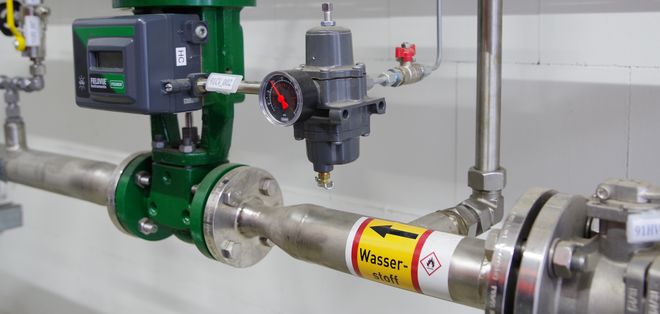
Tool for designing electrolysers on PV systems
What does this tool do?
The h2-well tool for designing electrolysers evaluates the most cost-effective, technically possible system configuration for a selected location based on user input for a weekly hydrogen requirement, e.g. for operating a bus fleet, as well as the specific investment costs for the electrolyser, photovoltaic system and H2 storage unit. In addition, the smallest possible system is output in each case. The calculation is based on securing the supply of hydrogen over an entire calendar year. Please note that it is assumed that the photovoltaic system, electrolyser and H2 storage system are at the same location and that the electrolyser is fed exclusively from photovoltaic electricity. The H2 storage tank is dimensioned larger than would be technically necessary for the supply task in order to take into account downtimes and maintenance times. The default values for the CAPEX prices are assumptions based on market data from mid-2025.
What does this tool not do?
The h2-well tool for designing electrolysers does not replace detailed dimensioning. It merely provides an initial approximation of target values. Operating costs or revenues from PV electricity not required for electrolysis are not taken into account. Furthermore, neither the costs for any necessary H2 compression nor for H2 transport or refuelling station infrastructure are taken into account.
Inputs for the analysis
For an analysis, please press the button 'Start evaluation' first. A chart will be created, the colour scheme of which you can adjust as needed.
Calculation basis for the design tool
Electrolyser - Assuming a PEM electrolyser with an output pressure of 35 bar and a power requirement of 55 kWhel to produce 1 kg of hydrogen. A minimum electrical output of 20% of the installed electrolysis output is required to operate the electrolyser, i.e. hydrogen is only produced for PV yields above this value.
PV system - The calculation is based on typical radiation data for the selected location. Electricity from the photovoltaic system that is not required for electrolysis is not taken into account in the calculation.
H2 storage - Cushion gas or pressure differences are not taken into account when analysing the H2 storage or the H2 supply.
Calculation method - The technically possible design variants for guaranteeing the supply task are analysed and presented in a 3D plot as limit size combinations of electrolyser output, PV system output and H2 storage size with the corresponding total costs for the investment.
Disclaimer
The h2-well tool for designing electrolysers is used exclusively for the initial technological and economic categorisation of an H2 generation system on a PV system. The calculations are approximate and do not represent specific system planning.
No guarantee or warranty is given for the accuracy of the results of the h2-well tool for designing electrolysers. Any liability for actions taken on the basis of the information in this tool is excluded.
Acknowledgements
The h2-well tool for designing electrolysers was developed as part of the BMFTR-funded research project for the h2-well strategy update in order to give interested parties a quick way to roughly estimate the investment costs of an electrolysis system in combination with a PV system, as this question is frequently asked in discussions.

